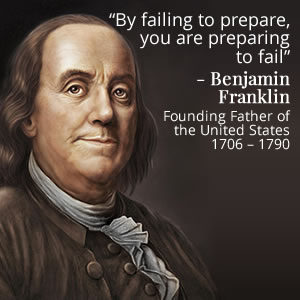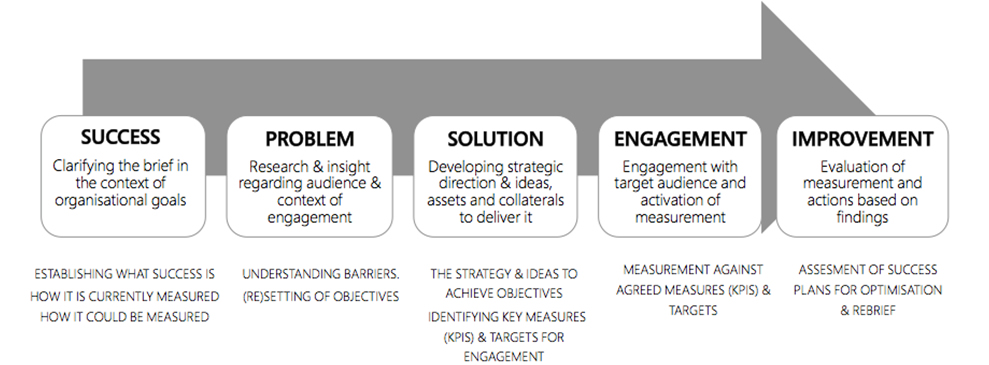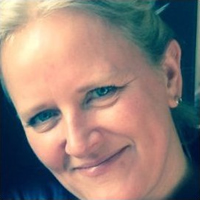Planning comes before everything else!

Get Directors of Strategy, Communications Directors, Digital and Communications teams
To be able to develop more strategically robust measurement strategies and plans that enable better evaluation of progress and setting of future direction
By explaining the role of planning as a function that ensures what we do ‘works’; and providing a very simple explanation of key planning stages through the lens of measurement and evaluation
‘If you fail to plan, you plan to fail’, Benjamin Franklin warned us over 200 years ago. And it’s as true today, especially for those of us charged with developing and executing communications strategies. Effective planning ensures we do the right things for the right reasons and in a way that facilitates meaningful measurement and evaluation.
The terms ‘measurement’ and ‘evaluation’ are often felt to be interchangeable or indistinguishable but in the context of communications programmes, and to fully comprehend the value of planning, it is vital that we understand the clear distinction between the two.
Measurement provides us with fact – the numbers, raw data and dashboards – of what we have done. Evaluation is the understanding of whether what we have done has had a real and relevant impact. For example, securing Facebook ‘likes’ is often perceived as a measure of success but deeper evaluation may reveal who those likes came from. Are they the people we intended to target?Did the ‘likes’ represent genuine engagement with our organisation as well as our message or content?
So measurement only has any value if it can tell us if our efforts have worked – if it can tell us we have used our resources effectively and efficiently and how we might adapt and improve for the better. In order to know this we have to be clear on what it is we are trying to achieve for our organisation and that is the role of planning.
Planning may take different forms depending on where it is conducted, but at its core, its purpose is always the same: to ensure what we do ‘works’. Planning combines insight and logical process that, together, guide us to be clear on what we want to achieve from any given activity and why. Planning enables us to best understand how we might best do it, how to evaluate it and improve it.
Insight:
The principal focus of any planner or planning team is to gain insight – through research, experience and expertise – into the target audience(s), the world in which they live and the ways we might engage them. When developing or responding to a brief, planners play a key role in establishing an understanding of the target audience, their broader social, cultural, technological and environmental context applying this knowledge within the organisation.
The other key focus of the planner is to leverage this understanding in developing actionable strategies for ideas and activities, and their measurement, that will benefit the organisation. This leads us to process.
Process:
Planning needs process. It ensures we ask and answer all the right questions in developing our strategy and activities and creates a framework for their subsequent measurement and evaluation. Below is a recommended, generic road map for a planning process that follows the key stages of Success, Problem, Solution, Engagement, and Improvement. This process is relevant to the many different kinds of activities we do – from traditional media campaigns to real-time social engagement. From these core stages an organisation can adapt and build its own unique, bespoke version of this process that is appropriate to the organisation and its methods.
As you will see from the above, the ‘insight’ phase of planning development feeds into the

‘process’ phase at the point of analysing ‘the problem’. From that moment on insight and process become inextricably linked, one informing the other.
Insight ensures we develop the right kinds of activities, delivered in the right context in a way to positively engage our target audience that takes us nearer to achieving our goals. Process ensures that we have established the right protocols to measure and evaluate these activities so we can judge their success and build upon that success in the future.
When it comes to measurement and evaluation, successful planning is the plan for success.
To move through each stage involves asking and answering the right questions. Here are some thought starters to build upon.
Success – Clarifying the brief in the context of organisational goals
- Do we know how this brief fits with our broader organisational goals?
- How do we currently measure progress towards these goals?
- What should happen as a result of this activity; what might success look like?
Problem – Research & insight regarding audience & context of engagement
- What data do we have and what do still need to know to answer this brief?
- Who is our target audience(s) and what do we want them to think, feel or do differently as a result of our activity?
- Looking at the audience, the broader context, our organisation and brand, what are the challenges we must overcome and what are therefore our objectives to guide us?
Solution – Developing strategic direction & ideas, assets and collaterals to deliver it
- What is our strategy for achieving our objectives; do we have a guiding creative thought and can we set tangible guidelines on message, content, tone, channel, timing and integration with other activities or assets?
- What are our ideas; the collaterals we need to build, the activities to implement?
- How might we measure how our audience engages with our activity? What are the most important measures (or KPIs) and can we set targets for each?
Engagement – Engagement with target audience and activation of measurement
- How is our audience engaging with our activity?
- What changes in how they think, feel or do can we track?
- Can we make adjustments now to improve delivery of our measurement targets?
Improvement – Evaluation of measurement and actions based on findings
- Does our measurement results show we delivered success?
- What does our evaluation of results tell us about what worked, didn’t work, or could work better?
- What do we do now? How shall we build the lessons learned into future activities?
 Lisa Story
Lisa StoryChief Strategy Officer, Cohn & Wolfe (UK and EMEA) and one of the champions of strategic planning as a discipline in the PR industry. Over the last 10 years, she has explored all four corners of the agency world to expand her knowledge, expertise and skills in digital and integrated marketing